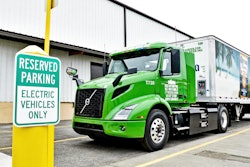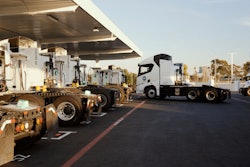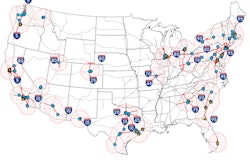One. Trillion. United States dollars.
That's a lot of money, and apparently that's what it's going to take to electrify the trucking industry, according to a report released a couple weeks ago by the Clean Freight Coalition, an alliance of truck transportation stakeholders whose founding members include the American Trucking Associations and Truckload Carriers Association, among others. Trucking's share of the $1 trillion lift is upwards of $620 billion for chargers, site infrastructure and electric service upgrades. Utilities and government slip by with $370 billion for upgrades to grid networks to meet the surge in demand of commercial vehicles alone.
[Related: EPA announces new strict emissions rule for heavy trucks]
If you tried to fundraise $1 trillion, you would need every living person in the world to donate $128.21.
To make that kind of money, Taylor Swift would have to set off on her record-smashing Eras tour another 961 times.
The $1 trillion price tag to go all battery electric is twice the gross domestic product of the United Arab Emirates, ironically one of the largest oil producing countries on the planet.
For those of us without a twin sibling, Dr. Teghan Lucas, forensic anthropologist at The University of New South Wales and Flinders University, both in Australia, says there is a 1 in a trillion chance that you ever run into another person that looks exactly like you.
A trillion bucks is also the rough equivalent of what's been spent on the entire power distribution system over the past 15 years, according to Dr. Wilfried Aulbur, Roland Berger senior partner responsible for the firm's global commercial vehicle, construction and agricultural business, and author of the report.
A trillion dollars, y'all. To go fully electric. And that's before anyone ever buys a truck.
1,000,000,000,000 ⬅️ that's what one trillion looks like written out; a one and 12 zeros.
You and I understand just how impossibly big that number sounds because we operate in a reality where margins matter and living within your means is the difference in being able to take that vacation with your family and eating cereal for dinner to save for it; one where an imbalance of big ideas and budget deficits will escort you into bankruptcy.
I participated in a media scrum the morning of the report's release. When Dr. Aulbur dropped the $1 trillion bomb, I don't think I was surprised. It's probably more than I would have guessed, but at some point numbers are so big they don't even matter anymore; a lot X a lot = a lot.
This is a fantasy-sized total anyway, right? If you were born with $1 trillion and lived to be 90 years old, you could spend $30,420,564 everyday and never run out of money. Brewster's Millions would need Monty Brewster's 30-day spending spree to last 1 million days.
Apple's profit margin on its iPhone is about 30%. Consumers shell out close to $1,000 every time a new one drops and think nothing of it. Aulbur noted in his report that trucking is an $800 billion enterprise with an average profit margin around 5%. Investing $620 billion would take every dollar of every $40 billion annual profit for nearly 16 years. That leaves nothing to buy trucks, even electric ones.
The year 2050 is a big date floating out there; one where many OEMs expect to be mostly, if not fully, battery electric (or at least zero emissions). That's barely 25 years from right now. If you tried to spread that $1 trillion need out over the next 25 years, it's $40 billion annually, and the trucking share over that same time is $24.8 billion. That feels more manageable, but that investment had to start yesterday (and construction had to start the day before), and most trucking companies have no idea how to start and many local utilities don't have the capabilities to help them start. It's a weird chicken and egg scenario where no one knows who is the chicken and who is the egg, and neither are ready to cross the road.
When the guy who authored the report, and Chris Spear and Jim Ward – heads of two trucking associations that collectively represent a huge population of trucking companies in the U.S. (including the largest) – each forewarn that the current trucking rate structure won't support this kind of investment, and they use words like "massive," "catastrophic," and "very, very high" to describe the potential rate increases needed to fund it, it should be alarming.
"We all know the cost is eventually going to be picked up in part by the consumer," said Jim Mullen, executive director of the Clean Freight Coalition.
I'm for green energy and I'm for zero emissions. I'm pro electric truck... where and when it makes sense. I'm pro natural gas, hydrogen, propane and, yes, diesel (renewable, bio and fossil) when and where they make sense, too. I'm anti whole fryer chickens at $6 per pound and eggs $7 a dozen. Even if the operational cost per mile of an electric is significantly lower than a diesel, it will take decades of reduced cost just to recoup upfront the investment. It's virtually impossible to envision a scenario where some (at a minimum) of these costs aren't passed down – by both the transportation industry and the utilities – to the consumer.
The prices of chickens and eggs will be untenable for those who don't raise them in backyard coops. Consumers will have to choose between latest iPhone, a vacation or groceries for the month. I am not a doomsday guy, but there is no reality where this isn't financially painful to some degree (or many degrees). A trillion dollars feels like something that's going to hurt.
I've watched this industry clean up emissions under stressful but realistic timeframes time and time again. It can do it again, and it's willing to do it again. But it's going to take multiple approaches, and its going to take time. "The trucking industry" isn't one thing. The equipment needs, access to capital and infrastructure available to a six-truck tanker fleet in rural Kentucky look nothing like those of a mega van fleet in Houston. This industry is comprised of multiple subcategories (truckload, LTL, tanker, reefer, etc.), and no member of each subcategory operates exactly like the other members.
Seeking to replace, in just 18 years, a primary source of power that has been validated and refined for over 130 years with a single cutting edge solution is a fool's errand, and you know what they say; "A fool and his money are soon parted." All one trillion dollars of it.












